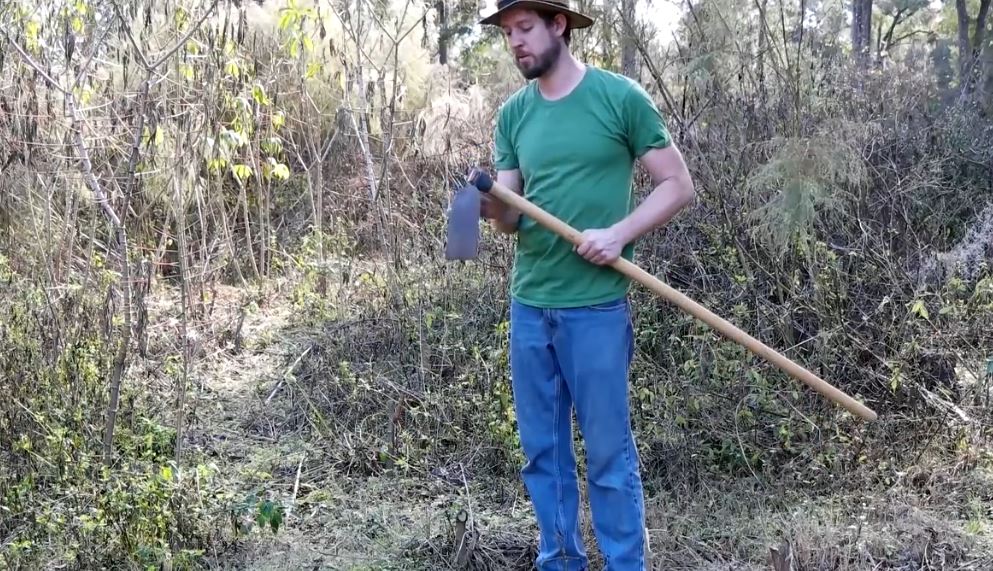There are some garden tools I find myself reaching for regularly.
My spade. My fork. My hoe. My broadfork.
And my grape hoe.
Especially when I’m clearing new ground and making beds.
You May Also Enjoy:
The grape hoe is a wide, tough hoe that is made for scraping the ground of weeds. It’s not a precision tool, like a scuffle hoe, a wire hoe, or the antique garden hoe I use in my beds. It’s a big beast, made for destroying large patches of weeds in a hurry. I got my grape hoe from EasyDigging.com years ago, and it’s still going strong.
Though it looks like a digging hoe (a.k.a. a “grub hoe”), the angle of the blade sweeps back on the handle so it scrapes the surface of the ground rather than chopping down into it.
This last week, I spent a lot of time clearing ground to plant corn, pigeon peas, and pumpkins.
My family helped as well, chopping vines and brush, string trimming, and punching holes in the ground for corn stations.
For the last bit of clearing, once we knocked most of the brush down to ground level, we used my grape hoe. It scratches and scrapes vines and grass off the surface of the soil. It’s also strong enough to chop through the woody perennial weeds and small tree seedlings that escaped our first round of clearing with machetes.
Though the grape hoe excels at weeding, I also use it to build garden beds. I like to make beds that are 4′ wide and as long as I can make them.
You May Also Enjoy: “Easy Raised Beds With Only 2 Tools”
If I’m planning a garden in a rough, uncleared area, we first go through with our machetes and chop everything down. Then we rake up all the fallen material to compost or burn, depending on how pernicious the weeds happen to be. I burn perennial bindweed vines and very seedy material, but chop up most everything else and use it as a rough mulch around my fruit trees.
Like I mentioned above, I then use the grape hoe to scrape the ground clean of bunchgrass and creeping vines, as well as chopping through woody stems that missed the first clearing.
Once the ground is bare, I get out my spading fork or broadfork and loosen the soil. When it’s all forked, I get my grape hoe again and shape the beds and paths, mounding up soil in the beds and lowering it in the paths. As I go, I yank roots and toss aside rocks. Smaller rocks can be worked out of the ground with the hoe, but I shovel out big ones or use my broadfork to pry them up.
You May Also Enjoy: “Product Review: The Meadow Creature Broadfork”
After the beds and paths are shaped (2′-wide paths are my favorite), I use a rake to make a nice seedbed and remove the remaining pieces of vines and roots.
A final note on grape hoes: if you get one, be sure it has a long handle or that you attach a long handle if you buy just the head.
Mine has a long, stout handle made from a thin wild coffee trunk. Having a long handle makes for a lot less work and bending. You don’t want to have to bend and scrape, as it’s unnecessarily tiring. I’ve seen pictures from Africa where farmers use 3′ handles and bend at the waist. I can’t do that and don’t want to! Long handles give you more leverage and are easier to work with.
If you don’t have a grape hoe already, I recommend the tool—it’s become indispensable on our homestead.
David The Good is a Grow Network Change Maker, a gardening expert, and the author of five books you can find on Amazon: Compost Everything: The Good Guide to Extreme Composting, Grow or Die: The Good Guide to Survival Gardening, Totally Crazy Easy Florida Gardening, Create Your Own Florida Food Forest, and Push the Zone: The Good Guide to Growing Tropical Plants Beyond the Tropics. Find fresh gardening inspiration at his website TheSurvivalGardener.com and be sure to follow his popular YouTube channel.








COMMENTS(1)
I loved the tool analysis video, partly because I know high quality tools pay for themselves and make one feel better while working, reducing body wear and tear. Thanks so much for the information, including the source of quality tools.